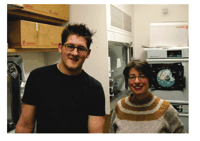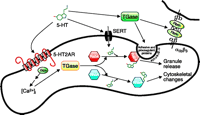Platelet Activation and “Crossover Appeal”: Rab and Rho Families United by Common Links to Serotonin
Platelets, small cell fragments derived from the cortical cytoplasm of megakaryocytes, circulate in an inactive form and adhere specifically to the endothelial cell lining of damaged blood vessels, where they rapidly become activated. Platelet activation is accompanied by dramatic morphological changes and the release of internal contents from several types of secretory granules. Release of these intracellular stores serves to further recruit and activate more platelets at the site of injury. Platelet activation ultimately results in the formation of a fibrin-stabilized platelet plug, which prevents excessive bleeding. These reactions are an essential response to bleeding; however, inappropriate activation of platelets produces clots in blood vessels, causing thrombosis. Therefore, the mechanisms underlying platelet adhesion and activation are of major biomedical interest.
Platelets can be purified in large quantities, making them an excellent experimental system; their use was instrumental in the characterization of one of the first identified mitogens: platelet-derived growth factor. Because platelets are relatively simple cells, lacking a nucleus, they also provide a great system to study signal transduction events that are not governed by, or dependent on, alterations in gene expression. Platelet aggregation involves a complex set of pathways that require the coordinated activity of a variety of receptors, including integrins, leucine-rich repeat adhesion proteins, and GPCRs; aggregation also engages regulatory feedback loops and interplay between signal transduction pathways and a multitude of agonists and antagonists. Delineating the specific contribution of each factor in this complex cascade is a major challenge for the field. Although pharmacological and genetic approaches have uncovered certain pathways critical to platelet activation, it is also clear that our knowledge of platelet physiology is far from comprehensive (1). The availability of genetically modified mice offers a powerful tool to elucidate the impact of different players in the pathway of platelet activation and their role in platelet physiology (2, 3). Walther and colleagues have made terrific use of this approach to examine the role of serotonin (5-HT) in platelet activation using mice lacking the gene for tryptophan hydroxylase 1 (Tph1), the rate-limiting enzyme for 5-HT biosynthesis. Tph1−/− mice contain normal levels of 5-HT in the brain, but are depleted of the monoamine outside the CNS and so are excellent models for studies of the diverse effects that have been ascribed to 5-HT in peripheral tissues (4, 5). Platelets express a cell-surface receptor for 5-HT (5-HT2AR) (6) and a specific serotonin uptake receptor (SERT) (7), in addition to a monoamine transporter (8) that allows platelets to accumulate high concentrations of 5-HT (~ 65 mM) in dense granules (9). Dense granule release is an early event of platelet activation and is thought to occur prior to the exocytosis of the larger α-granules, which contain a variety of proaggregatory proteins, including von Willebrand factor (vWf) (10, 11).
Platelets derived from Tph1−/− mice clearly demonstrate a requirement for intracellular 5-HT together with Ca2+ for the release of α-granules during platelet activation. But what is the mechanism of action of 5-HT?
On the exterior of platelets, 5-HT is a substrate for Factor XIIIa, an enzyme with transglutaminase (TGase) activity (12). TGs are a family of enzymes of wide physiological importance (13), and catalyze the formation of isopeptide bonds between specific glutamine residues (acyl-donor), and either lysine or simple amine-containing compounds (amino-donor), in a Ca2+-dependent manner. In addition to serotonin, many other biologically active compounds containing primary amines, such as histamine and catecholamine can be utilized as substrates by TGases (14). Platelet Factor XIIIa uses 5-HT to transamidate (“serotonylation”) vWf and other proaggregatory proteins released by platelets from α-granules, enhancing their adhesive properties on the exterior of the platelet. Because platelets also contain high levels of intracellular TG (15), Walther and coworkers looked for substrates of intracellular TG that were transamidated with 5-HT. They focused their attention on small GTPases of the Ras superfamily because these are known substrates for bacterial TGases (16–18). Incubation of activated platelets with radiolabelled 5-HT revealed both high molecular mass targets of TG action, and low molecular mass proteins including the small GTPases RhoA and Rab4––members of the Ras superfamily that have been implicated in cellular responses involving the actin-mediated cytoskeleton and membrane trafficking, respectively (19).
Walther et al. found that intracellular platelet TGase covalently modifies RhoA and Rab4 with 5-HT at a position in the phosphate-binding site that is conserved among the sequences of all small Ras-related GTPases (20). A glutamic acid residue that is required for hydrolysis of the bound nucleotide occupies this site. Replacement or blockage of this active-site residue results in a mutant with diminished intrinsic GTPase activity. Such a mutation will stabilize the protein in the activated GTP-bound form of the molecule, which potently enhances its biological impact (19). Thus, with a single step, the platelet-activated response cascade activates both a Rho family member involved in mediating cytoskeletal rearrrangements, and a Rab family member involved in mediating granule exocytosis (21, 22).
One has to admire the elegance of this mechanism (Figure 1⇓), utilizing the commonality of GTPase activation mechanisms to coordinate their diverse downstream functions, in addition to utilizing the same signal transduction effector, TGase, to coordinate intra- and extracellular events.
The findings of Walther and colleagues directly point to the potential of 5-HT reduction as a target for the treatment of thrombotic disease. This exciting discovery also illuminates a new world of possibility for the regulation of small GTPases. It is often convenient to think of small GTPases as binary switches, whose interconversion is regulated by guanine nucleotide exchange factors (GEFs) and GTPase-accelerating factors (GAPs). However, this is not the only mechanism cells have available to regulate small GTPase activity. Several specific instances of regulation by phosphorylation have been documented, including platelet-localized Rab proteins (23). More generally, the prenyl modification of several small GTPase subfamily members offers a means for regulating their activity through the reversible association with membranes (24). Now we know that TGase can activate small GTPases by monoaminylation through their universally conserved active-site glutamine. It is very possible that TGase-dependent modification is a universal principle of GTPase regulation, which has huge implications for biology given the plethora of pathways that make use of Ras-related GTPases. Other instances where endogenous TGase activates small GTPases, in addition to platelet aggregation, are eagerly awaited.
Serotonin pathways leading to α-granule exocytosis. Serotonin (5-HT) is actively imported into platelets by the serotonin transporter (SERT) and stored in dense granules. 5-HT-mediated stimulation of the 5-HT receptor (5-HT2AR) results in a rise in intracellular calcium [Ca2+]i. Transglutaminase (TGase) is activated by Ca2+ and utilizes 5-HT to transamidate RhoA or Rab4, rendering them constitutively active by blocking GTP hydrolysis. Activation of RhoA and Rab4 leads to cytoskeletal rearrangements and α-granule exocytosis, respectively. Proaggregatory factors released from a-granules include von Willebrand factor (vWf), Factor V, and fibrinogen, all of which have been shown to be substrates for transamidation. Transamidation of these proaggregatory factors with 5-HT enhances their adhesive properties, localizing these factors to the activated platelet membrane where they then participate in further platelet activation events. Extracellular TGase, (Factor XIIIa) also cross-links fibrin bound to its receptor α11bβ3 which stabilizes the newly-formed platelet plug.
- © American Society for Pharmacology and Experimental Theraputics 2004
References

Ruth Collins, PhD, (right) is an Assistant Professor and Chris Heger, BS, (left) is a Graduate student in the Department of Molecular Medicine, College of Veterinary Medicine, Cornell University. Their research focuses on Rab GTPase signaling in model organisms and mammalian cells. Address correspondence to RNC. Email rnc8{at}cornell.edu; fax 606-253-3659.




